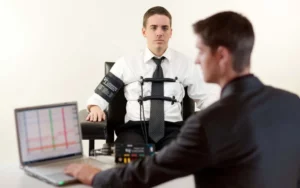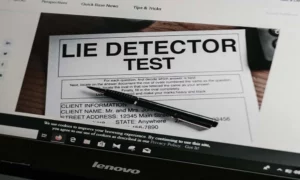Polygraph tests are used frequently in many fields, such as law enforcement, national security, and private investigations. The exam is typically broken down into four phases: the initial interrogation and pre-test phase, the in-test (polygraph exam), and the post-test phase. Each phase plays an essential role in the testing procedure.

Initial interrogation and pre-test phase
The initial interrogation and pre-test are the first and second of four phases, often referred to only as the “pre-test.” They take place a few weeks or days before the actual exam.
The pre-test interview is an essential part of a polygraph examination, as it sets the foundation for the entire exam. During the pre-test phase, the examiner will gather critical information to better understand the case.
You’ll be questioned about the subject that will be covered in the actual exam and might also be asked how you feel about possible punishments and suspicions relating to it.
You’ll be asked questions in both an accusatory and non-accusatory manner to record your reactions to both approaches. During this conversation, your verbal and non-verbal reactions will be observed, and a picture of your honest and dishonest behavior will be compiled.
The answers you give and your behavioral indicators will be used to build the questions for the in-test phase.
The purpose of the pre-test interview
As mentioned, the pretest is designed to build up the questions for the actual exam. There may also be a demonstration of the polygraph’s accuracy in detecting deception to make you feel uncomfortable lying.
Aside from these, there are several more reasons for the pre-test phase that are mainly intended for the examiner:
- Establish rapport: As an examinee, you may be nervous or anxious about the upcoming exam, so it’s crucial that the examiner create a comfortable and relaxed environment for you. By establishing a rapport with you, the examiner can help reduce stress and anxiety, which can lead to more accurate results during the in-test phase.
- Gather essential background information: The examiner will ask questions about your personal and professional history, as well as your involvement in the case being investigated. This information will help the examiner better understand your motivations and behavior, which can help them interpret the results of the in-test phase accurately.
- Explain the purpose and procedure of the exam to you. The examiner will go over the consent forms and answer any questions they may have.
- Obtain a record of your answers to unambiguous questions.
- Recognize your behavioral patterns, both verbal and non-verbal, when you give honest and dishonest answers, such as fidgeting, sweating, eye movement, etc.
- Finally, the pre-test interview provides an opportunity for the examiner to assess your suitability for the exam. In some cases, an examinee may not be suitable for a polygraph examination due to medical or psychological reasons.
Types of questions asked during the pre-test phase

The questions asked during this phase can be broadly categorized into five types: personal, case-related, medical/psychological, test-related, and control.
- Personal Questions: The examiner may start by asking personal questions. These may include questions about your family, hobbies, and interests.
- Case-Related Questions: He will ask questions related to the case being investigated. These may include questions about your involvement in a case, your knowledge of certain facts, and the motivations behind your actions.
- Medical and psychological questions: he may ask questions about your medical and psychological history. These are designed to identify any physical or mental conditions that may affect the accuracy of the test results. For example, a history of anxiety disorders or heart conditions that could impact the results of the exam.
- Test-Related Questions: Finally, the examiner may ask questions related to the test itself. These may include questions about your understanding of the test process, your willingness to participate, and your understanding of the consequences of the test results. These will help him ensure that you are fully informed and willing to participate in the exam.
- Control questions: Control questions are designed to establish a baseline for your physiological responses. These may be uncomfortable or embarrassing, but they are not related to the case being investigated. The examiner will use the responses to these questions to compare them to your responses to the relevant questions during the in-test phase.
When will the pre-test be administered?
Depending on the industry and type of polygraph examination, the pre-test may take place a few weeks prior to your polygraph, and a second one may take place immediately before it.
In most private sector polygraphs, you will be asked to participate only in the interrogation that occurs immediately before it. In those cases, your interrogator will also be your test examiner.
What happens after the pre-test?
When the pre-test is done, the polygraph procedure will be described, and you will be given the relevant questions (though this does not always happen).
After you are comfortable with the decision to move forward, you will be asked to sign a declaration form to state that you are agreeing to take the polygraph and understand the procedure.
In some cases, if you feel uncomfortable with the examiner, the process can be stopped and arrangements will be made for a different examiner to conduct the test at another time.
In-test phase (polygraph exam)

The exam phase is the third of four phases. It is known as the “in-test procedure” or “chart collection phase.” During this phase, the examiner will attempt to gather verbal and physical evidence of your truthfulness and deception.
The in-test phase is the main part of the process, where the examiner records your physiological responses to a series of questions. This phase typically lasts between 30 minutes and 3 hours and is divided into several smaller parts.
First, the examiner will attach the sensors to your body, which will measure your physiological responses such as blood pressure, pulse, respiration, and sweat gland activity. These sensors are attached to the fingers, chest, and abdomen.
Next, the examiner will begin asking the relevant and control questions. He will ask each question multiple times to ensure accurate readings and may also ask follow-up questions to clarify the response.
During this phase, the examiner will monitor your physiological responses through the sensors. A significant change in these responses may indicate deception or stress.
It’s important to note that the examiner will not make any judgments about your truthfulness during the in-test phase. Instead, he will only record the data collected; interpreting the results happens during the post-test phase.
Types of polygraph examinations
Polygraph testing can be broken down into several specific types, each with its own unique approach and methodology.
Control Question Test (CQT): One type of polygraph test is the Control Question Test (CQT), which is the most commonly used method. During a CQT, the person being tested is asked a series of questions, some of which are control questions designed to elicit a physiological response from the person. These control questions are typically designed to be vague and non-threatening, such as “Have you ever lied to anyone?” The person’s physiological response to these questions is then compared to their response to the relevant questions, which are designed to determine their truthfulness about a specific incident or event.
Guilty Knowledge Test (GKT): Another type of polygraph test is the Guilty Knowledge Test (GKT), which is sometimes referred to as the “Concealed Information Test.” This type of test is typically used to determine if a person has specific knowledge related to a crime or event. During a GKT, the person is shown a series of stimuli, such as pictures or words, and their physiological responses are measured. If the person’s response is stronger to a particular stimulus, it may indicate that they have specific knowledge related to that stimulus.
The Concealed Information Test (CIT): is a type of polygraph test that is similar to the GKT in that it is used to determine if a person has specific knowledge related to a crime or event. However, the CIT focuses more on the person’s reactions to stimuli that are directly related to the event in question. For example, if the person is suspected of stealing a specific item, the CIT may involve showing them pictures of the stolen item and measuring their physiological responses.
Neuroscience-based advanced test: Finally, there are also neuroscience-based advanced polygraph tests, which use a combination of traditional polygraph techniques and neuroimaging to measure brain activity in response to questioning. These tests are still in the experimental phase and are not yet widely used in practice.
Instances in which polygraph tests are used
The different polygraph test types can be used to suit various purposes. Here are some of the most common ones:
- Specific-Issue Test: This type of test is used to determine the truthfulness of a particular incident or statement. The examiner will ask specific questions related to the incident.
- Pre-employment screening: Such a test is often used by employers to screen job candidates for certain positions. The questions are typically focused on the candidate’s qualifications, background, and suitability for the job. Pre-employment screening tests are designed to identify potential security risks, such as theft or espionage, or to determine if the candidate has provided false information on their job application.
- Periodic Screening: This kind of test is similar to pre-employment screening but is used on employees who are already working for a company. Periodic screening is used to ensure that employees are continuing to meet the company’s standards and are not engaging in any behavior that could be detrimental to the company.
- Criminal Investigation: This is used by law enforcement agencies to investigate criminal cases. The questions are focused on the specific incident being investigated, and the examiner will try to determine if the person being tested was involved in the crime.
- Quality Control: This type is used to ensure the accuracy of information provided by employees in certain industries. For example, employees who work in the pharmaceutical or financial industries may be required to take a polygraph test to ensure that they are following protocols and not engaging in any unethical behavior.
Who will administer your exam?
Polygraph examiners, sometimes called polygraphers or polygraphists, typically have a bachelor’s degree, a background in criminal justice or psychology, and have undergone polygraph training.
The type of examiner will depend on the circumstances and nature of the test, i.e., the reason you are taking a polygraph, and should be certified by a regulating organization like the American Polygraph Association.
Will the exam be recorded?
In most cases, it will be recorded. Standard protocol is to audio record every polygraph examination in its entirety. This is to ensure the results can be re-examined if necessary and provide thorough details if the results are ever questioned by you or your attorney.
How is the test environment set up?

There are certain standard environmental settings you can anticipate; however, the location of the test depends on the purpose of the exam and the organization conducting it. Typically, it will include:
- a small room containing only a table and chairs.
- Most of the time, the room will be simple and plain, and it shouldn’t have any decorations or pictures that might be distracting.
- During the examination, you and your examiner will usually be the only people in the room, though an attorney may be present in some cases.
Post-Test Phase
The post-test phase is the fourth and final phase of the polygraph examination, and it serves as the last step in the evaluation of your honesty and credibility. During this phase, the examiner will review the charts and data collected during the in-test phase and make a determination regarding your truthfulness.
Your gathered data will be examined for abnormalities, including skin resistance or sweat levels, heart rate, blood pressure, and breathing, in response to the questions discussed earlier.
The purpose of the post-test phase
The primary purpose of the post-test phase is to provide you with an opportunity to explain any reactions that were recorded on the polygraph charts. The examiner will ask about any medical conditions or other factors that may have influenced the results, such as medications or psychological conditions. Additionally, the examiner may ask follow-up questions to clarify any discrepancies or inconsistencies in the responses.
He will also explain the results. If he determines that you were truthful, he will provide feedback. On the other hand, if he determines that you were deceptive, he will explain their findings and provide you with an opportunity to explain discrepancies.
In some cases, he may also use the post-test interview to elicit additional information from you. For example, if your responses during the test were ambiguous or unclear, the examiner may ask follow-up questions to gather more information.
In some cases, the examiner may also provide you with recommendations for further evaluation or treatment. For example, if you exhibited significant levels of stress during the examination, he may suggest that you seek counseling or medical attention.
Follow-up investigations
After the post-test phase has been conducted and the examiner has made a determination of your truthfulness or deception, a follow-up investigation may take place.
If the results indicate deception, further investigation may be needed to determine the nature and extent of the deception. This may involve conducting additional interviews, gathering more information, and examining physical evidence. It’s important that the examiner approach the investigation with an open mind and avoid making assumptions based solely on the results of the polygraph.
On the other hand, if the results of the examination indicate truthfulness, the investigation may be considered complete. However, the polygraph examination is not 100% foolproof, and false negatives can occur. Therefore, if there is reason to suspect deception, further investigation may still occur.
Final Thoughs

Each phase of the polygraph examination process plays an important role in determining your truthfulness. The pre-test interview establishes a baseline for comparison, the chart collection phase records physiological data, the data analysis phase interprets that data, and the follow-up investigation phase clarifies any issues that may have arisen. Through a thorough and professional polygraph testing process, examiners can provide reliable information to help make accurate decisions in various contexts, such as employment screenings, criminal investigations, and security clearance evaluations.
Good luck!

